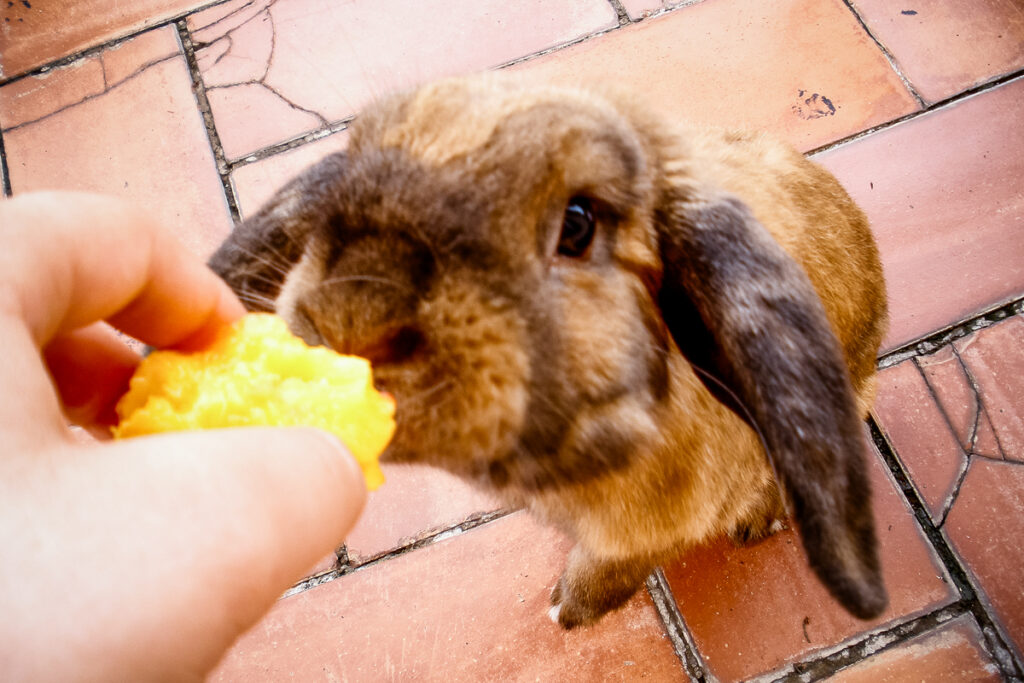That cute little whiskered face is so hard to ignore, especially when your bun sits up and looks so deserving of that special treat. And pet stores sell a selection of rabbit treats which are perfect for your precious rabbit. Right? WRONG! Most so-called rabbit treats are the equivalent of taking your rabbit to McDonald’s, providing non-nutritious junk that can cause potential harm to your rabbit. Confusing the issue is that many of these products use phrases that lead the buyer to believe that the product is healthful: “nutritionally fortified,” “doing right for the environment,” “natural feeding habits,” “for nutritional variety,” “the finest selected ingredients.” The addition of “feeding instructions” and “guaranteed analysis” lend a cache of authority.
Commercial rabbit treats fall into several catagories: pellets, processed cereal kibble, mueslix (dried seed/fruit/veggie mixes), cereal/veggie blends, and candies/sugars. None confer an advantage over the fresh vegetable, high fiber pellets, and unlimited hay diet.
PELLETS
Pellets were discussed in HRJ vol. III #4. I won’t say more here except to repeat those guidelines: choose a pellet that is high in fiber (20-25%) and low in protein (14-15%) and calcium (<1.0%). Restrict pellet feedings to [best practice guidelines] and feed plenty of fresh vegetables and unlimited hay. Do not buy a pellet that contains seeds, nuts, or starch-rich cereal kibble mixed in (see below).
PROCESSED CEREAL KIBBLE
These range from “Crunchy Puffs” to shaped products designed to substitute for pellets. Some contain expensive extras that serve no benefit to your rabbit, such as plant or herbal extracts and freeze dried bacteria. One contains less than the National Research Council (NRC) requirements for calcium. Another contains cheese flavoring! Supplementation with digestive enzymes (proteases, amylases) normally is unnecessary because these foods are highly digestible and because there is no evidence that healthy rabbits produce insufficient levels of these enzymes; in fact, some of the most important digestion is by the cecal bacteria. These kibbles tend to be lower in fiber and higher in fat. They are also extremely expensive and come with feeding recommendations destined to give a spayed or neutered house rabbit obesity. The variety of colors and shapes are more of an asthetic to the human buyer than to your rabbit. Again, fresh vegetables, restricted high fiber pellets, and unlimited hay are healthier and easier on your budget.
MUESLIX
These are mixes which are made of seeds and grains. They are marketed as “vitamin and mineral enriched,” a “delicious energy provider,” or “fortified.” They are made of carbohydrate and fat-rich seeds and grains such as oats, milo, corn, peas, sunflower seeds, potatoes, peanuts, puffed corn, cornflakes, popcorn, and dried fruits. They are often held together into “sticks” with honey and other sugars, and are marketed with the explanation that they supply needed energy and reflect the rabbit’s normal diet.
In reality, a diet of vegetables, hay and restricted pellets provides all the nutrients and energy your house rabbit needs. Seeds are high in fat and are important for wintering animals. Your house rabbit has no such need; in fact, the National Research Council recommends that domestic rabbits receive no more than 1.5% of their calories as fat. Labels on the back of these mueslix products list a minimum fat content of 4-5%; the real value is probably greater. Rabbit metabolism is geared for a low fat diet (in comparison, the average human diet contains 35-40% fat!), and the excess is not burned but is stored as body fat. Rabbits appear to be more sensitive to fat than are humans, and in addition to obesity, the excess fat can accumulate in your rabbit’s liver and arteries (atherosclerosis). Veterinarians have reported that rabbits fed seed-rich diets have a much higher incidence of fatty liver disease (hepatic steatosis), which is often fatal. These seeds and grains are also rich in starches. While some of this starch is digested in the small intestine, much of it is not accessible until it reaches the cecum. There it becomes a potent energy form for the cecal bacteria; unlike cellulose fiber, which slows fermentation, starch in the cecum is fermented rapidly and can lead to bacterial overgrowth, bloat, and gi stasis.
Manufacturers claim that seeds and grains satisfy “the chewing urge.” While this is true, it is far safer and cheaper to satisfy that urge with baskets, untreated wood, and cardboard boxes.
CEREAL/VEGGIE BLENDS
These are grain products which may be supplemented with dehydrated vegetables, and shaped into a form which mimics a vegetable product. There is no advantage to feeding these over the real vegetable. One product label lists three different cereals before the dehydrated vegetable! The high carbohydrate content of these snacks means they are robbing your rabbit of important fiber and overloading him with sugars. These products also tout the vitamins that are added back (due to processing); real vegetables will supply as much if not more. With 2.1 ounces costing $3.09 ($24 per pound), a pound of carrots and some cardboard provides a healthier and cheaper alternative.
CANDIES/SUGARS
These can include everything from yogurt drops to sweetened papaya tablets. The high sugar is the culprit here. Many rabbits have a sweet tooth, but sweetness means a high content of sugars. As we discussed above, excessive sugar is converted to fat, or will pass into the cecum where the bacteria will use it for energy and then rapidly overgrow, possibly leading to bacterial imbalance and gi stasis. The same can occur after feeding too much fruit. Avoid feeding your rabbit simple sugars and instead stick with nutritious treats such as vegetables and herbs; save the sweets for an occasional raisin or banana snack.
VITAMIN SUPPLEMENTS
These are largely unnecessary. For nearly all rabbits, a diet containing a variety of fresh vegetables, restricted high quality pellets, and unlimited hay provides all the vitamins your rabbit requires; many of your rabbit’s vitamins come from her normal ingestion of cecal pellets. While special health situations may require nutrient supplements, these are best handled after consultation with your veterinarian.
It is tempting to show your love for your rabbit by purchasing treats for her. If you are in doubt, read the ingredient label; pay particular attention to the list of ingredients (they are listed in order of abundance) and the percentage of fiber and fat. Speaking as a nutritionist, my best advice is to save your money and show your love with healthy treats like vegetables, hay and untreated wood for chewing. And give plenty of pets, which are of course free.
Susan Smith, PhD

